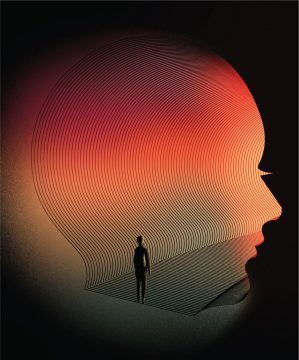Christof Koch in Scientific American:
 A young Ernest Hemingway, badly injured by an exploding shell on a World War I battlefield, wrote in a letter home that “dying is a very simple thing. I’ve looked at death, and really I know. If I should have died it would have been very easy for me. Quite the easiest thing I ever did.” Years later Hemingway adapted his own experience—that of the soul leaving the body, taking flight and then returning—for his famous short story “The Snows of Kilimanjaro,” about an African safari gone disastrously wrong. The protagonist, stricken by gangrene, knows he is dying. Suddenly, his pain vanishes, and Compie, a bush pilot, arrives to rescue him. The two take off and fly together through a storm with rain so thick “it seemed like flying through a waterfall” until the plane emerges into the light: before them, “unbelievably white in the sun, was the square top of Kilimanjaro. And then he knew that there was where he was going.” The description embraces elements of a classic near-death experience: the darkness, the cessation of pain, the emerging into the light and then a feeling of peacefulness.
A young Ernest Hemingway, badly injured by an exploding shell on a World War I battlefield, wrote in a letter home that “dying is a very simple thing. I’ve looked at death, and really I know. If I should have died it would have been very easy for me. Quite the easiest thing I ever did.” Years later Hemingway adapted his own experience—that of the soul leaving the body, taking flight and then returning—for his famous short story “The Snows of Kilimanjaro,” about an African safari gone disastrously wrong. The protagonist, stricken by gangrene, knows he is dying. Suddenly, his pain vanishes, and Compie, a bush pilot, arrives to rescue him. The two take off and fly together through a storm with rain so thick “it seemed like flying through a waterfall” until the plane emerges into the light: before them, “unbelievably white in the sun, was the square top of Kilimanjaro. And then he knew that there was where he was going.” The description embraces elements of a classic near-death experience: the darkness, the cessation of pain, the emerging into the light and then a feeling of peacefulness.
Near-death experiences, or NDEs, are triggered during singular life-threatening episodes when the body is injured by blunt trauma, a heart attack, asphyxia, shock, and so on. About one in 10 patients with cardiac arrest in a hospital setting undergoes such an episode. Thousands of survivors of these harrowing touch-and-go situations tell of leaving their damaged bodies behind and encountering a realm beyond everyday existence, unconstrained by the usual boundaries of space and time. These powerful, mystical experiences can lead to permanent transformation of their lives.
…Why the mind should experience the struggle to sustain its operations in the face of loss of blood flow and oxygen as positive and blissful rather than as panic-inducing remains mysterious. It is intriguing, though, that the outer limit of the spectrum of human experience encompasses other occasions in which reduced oxygen causes pleasurable feelings of jauntiness, light-headedness and heightened arousal—deepwater diving, high-altitude climbing, flying, the choking or fainting game, and sexual asphyxiation. Perhaps such ecstatic experiences are common to many forms of death as long as the mind remains lucid and is not dulled by opiates or other drugs given to alleviate pain. The mind, chained to a dying body, visits its own private version of heaven or hell before entering Hamlet’s “undiscovered country from whose bourn no traveler returns.”
More here.
